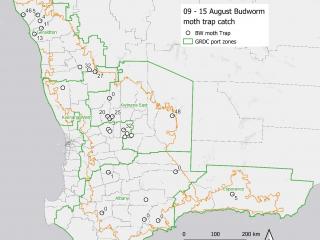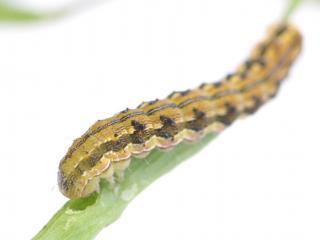Native budworm caterpillars are appearing in the northern region
- Yallabatharra
- Nolba
- Ogilvie
Following on from the significant numbers of native budworm moths detected in moth traps in the northern agricultural region in late June and early July, caterpillars are now being found in some crops in the area.
In the past week Research Scientist Andrew Phillips (DPIRD) reported finding around 21 native budworm larvae per 10 sweeps in a canola crop near Yallabatharra. He also netted an average of one larva per 10 sweeps in a canola crop near Nolba.
Interestingly, no native budworm larvae have been reported from canola crops near Moonyoonooka, Wicherina and Marrah where large numbers of moths were reported in late June and early July.
This week, Nic McKenna (Planfarm) reported that native budworm caterpillars were damaging the flag leaves of wheat at Ogilvie. Based on a recently completed GRDC-funded project, economic losses are estimated at $1.71 per hectare, when there are 5 larvae per square metre (approx. 50 larvae per 10 sweeps), or $2.75 per hectare loss when there are 10 larvae per square metre (approx. 100 larvae per 10 sweeps). This is based on a $360 per tonne wheat price and anticipated yield of 2 tonnes per hectare. For more information, refer to the GRDC Groundcover article 'Is native budworm targeting wheat crops?'.
Large numbers of native budworm moths do not always equate to large numbers of larvae. Only a small proportion of eggs laid by native budworm moths survive to the damaging large caterpillar stage. Eggs and very small larvae can be dislodged and will die after heavy rain or wind. Predators, disease and parasites also affect numbers in some seasons.
Native budworm moth trapping update
This week, the largest numbers of native budworm moths caught in pheromone traps were reported at Southern Cross (48 moths), Maya (32), Kellerberrin N (32), Cunderdin N (25) and Dowerin (20).
Over a 21-day period, moth counts reported from the Geraldton region were 138 moths in Yallabatharra, 41 in Mooyoonooka, 33 in Wicherina and 12 in Marrah. This is significantly less than in June and early July.

A mapped view of the native budworm trap captures is available at Cesar Australia’s MothTrapVisWA page. Users need to select the desired trapping date range.
More results of this week's trappings are available for viewing at the department’s native budworm moth numbers 2023 page.
Pesticide options for the control of native budworm can be found in DPIRD’s 2023 Winter Spring Insecticide Guide.
Growers and agronomists should be aware that the active ingredient cyantraniliprole is now registered for use on native budworm and diamondback moth on canola.
Detailed information on this pest can be found at the department’s management and economic thresholds for native budworm.
To read about earlier native budworm activity this season, refer to the 2023 PestFacts WA Issue 9 article, 'native budworm are active early'.
For more information, contact Technical Officer Alan Lord in South Perth on +61 (08) 9368 3758 or +61 409 689 468.
Article authors: Alan Lord (DPIRD South Perth) and Bec Severtson (DPIRD Northam).

